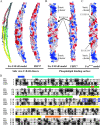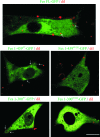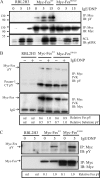Contributions of F-BAR and SH2 domains of Fes protein tyrosine kinase for coupling to the FcepsilonRI pathway in mast cells
- PMID: 19001085
- PMCID: PMC2612524
- DOI: 10.1128/MCB.00904-08
Contributions of F-BAR and SH2 domains of Fes protein tyrosine kinase for coupling to the FcepsilonRI pathway in mast cells
Abstract
This study investigates the roles of Fer-CIP4 homology (FCH)-Bin/amphiphysin/Rvs (F-BAR) and SH2 domains of Fes protein tyrosine kinase in regulating its activation and signaling downstream of the high-affinity immunoglobulin G (IgE) receptor (FcepsilonRI) in mast cells. Homology modeling of the Fes F-BAR domain revealed conservation of some basic residues implicated in phosphoinositide binding (R113/K114). The Fes F-BAR can bind phosphoinositides and induce tubulation of liposomes in vitro. Mutation of R113/K114 to uncharged residues (RK/QQ) caused a significant reduction in phosphoinositide binding in vitro and a more diffuse cytoplasmic localization in transfected COS-7 cells. RBL-2H3 mast cells expressing full-length Fes carrying the RK/QQ mutation show defects in FcepsilonRI-induced Fes tyrosine phosphorylation and degranulation compared to cells expressing wild-type Fes. This correlated with reduced localization to Lyn kinase-containing membrane fractions for the RK/QQ mutant compared to wild-type Fes in mast cells. The Fes SH2 domain also contributes to Fes signaling in mast cells, via interactions with the phosphorylated FcepsilonRI beta chain and the actin regulatory protein HS1. We show that Fes phosphorylates C-terminal tyrosine residues in HS1 implicated in actin stabilization. Thus, coordinated actions of the F-BAR and SH2 domains of Fes allow for coupling to FcepsilonRI signaling and potential regulation the actin reorganization in mast cells.
Figures







Similar articles
-
FES/FER kinase signaling in hematopoietic cells and leukemias.Front Biosci (Landmark Ed). 2012 Jan 1;17(3):861-75. doi: 10.2741/3961. Front Biosci (Landmark Ed). 2012. PMID: 22201778 Review.
-
Association of 3BP2 with SHP-1 regulates SHP-1-mediated production of TNF-α in RBL-2H3 cells.Genes Cells. 2011 Dec;16(12):1133-45. doi: 10.1111/j.1365-2443.2011.01557.x. Epub 2011 Nov 13. Genes Cells. 2011. PMID: 22077594
-
FES kinase promotes mast cell recruitment to mammary tumors via the stem cell factor/KIT receptor signaling axis.Mol Cancer Res. 2012 Jul;10(7):881-91. doi: 10.1158/1541-7786.MCR-12-0115. Epub 2012 May 15. Mol Cancer Res. 2012. PMID: 22589410
-
Fer and Fps/Fes participate in a Lyn-dependent pathway from FcepsilonRI to platelet-endothelial cell adhesion molecule 1 to limit mast cell activation.J Biol Chem. 2006 Jul 28;281(30):20949-20957. doi: 10.1074/jbc.M604252200. Epub 2006 May 26. J Biol Chem. 2006. PMID: 16731527
-
Syndapin--a membrane remodelling and endocytic F-BAR protein.FEBS J. 2013 Nov;280(21):5198-212. doi: 10.1111/febs.12343. Epub 2013 Jul 5. FEBS J. 2013. PMID: 23668323 Review.
Cited by
-
Kinome analysis of receptor-induced phosphorylation in human natural killer cells.PLoS One. 2012;7(1):e29672. doi: 10.1371/journal.pone.0029672. Epub 2012 Jan 4. PLoS One. 2012. PMID: 22238634 Free PMC article.
-
Electroporation-mediated delivery of FER gene enhances innate immune response and improves survival in a murine model of pneumonia.Gene Ther. 2018 Aug;25(5):359-375. doi: 10.1038/s41434-018-0022-y. Epub 2018 Jun 15. Gene Ther. 2018. PMID: 29907877 Free PMC article.
-
Chemical genetics strategy to profile kinase target engagement reveals role of FES in neutrophil phagocytosis.Nat Commun. 2020 Jun 25;11(1):3216. doi: 10.1038/s41467-020-17027-5. Nat Commun. 2020. PMID: 32587248 Free PMC article.
-
BAR domain proteins-a linkage between cellular membranes, signaling pathways, and the actin cytoskeleton.Biophys Rev. 2018 Dec;10(6):1587-1604. doi: 10.1007/s12551-018-0467-7. Epub 2018 Nov 19. Biophys Rev. 2018. PMID: 30456600 Free PMC article. Review.
-
Phospholipid binding residues of eukaryotic membrane-remodelling F-BAR domain proteins are conserved in Helicobacter pylori CagA.BMC Res Notes. 2014 Aug 13;7:525. doi: 10.1186/1756-0500-7-525. BMC Res Notes. 2014. PMID: 25115379 Free PMC article.
References
-
- Abramson, J., and I. Pecht. 2007. Regulation of the mast cell response to the type 1 Fc epsilon receptor. Immunol. Rev. 217231-254. - PubMed
-
- Anderson, D. H., and P. M. Ismail. 1998. v-fps causes transformation by inducing tyrosine phosphorylation and activation of the PDGFβ receptor. Oncogene 162321-2331. - PubMed
-
- Aspenstrom, P., A. Fransson, and N. Richnau. 2006. Pombe Cdc15 homology proteins: regulators of membrane dynamics and the actin cytoskeleton. Trends Biochem. Sci. 31670-679. - PubMed
-
- Balla, T., and P. Varnai. 2002. Visualizing cellular phosphoinositide pools with GFP-fused protein-modules. Sci. STKE 2002PL3. - PubMed
Publication types
MeSH terms
Substances
LinkOut - more resources
Full Text Sources
Molecular Biology Databases
Research Materials
Miscellaneous
